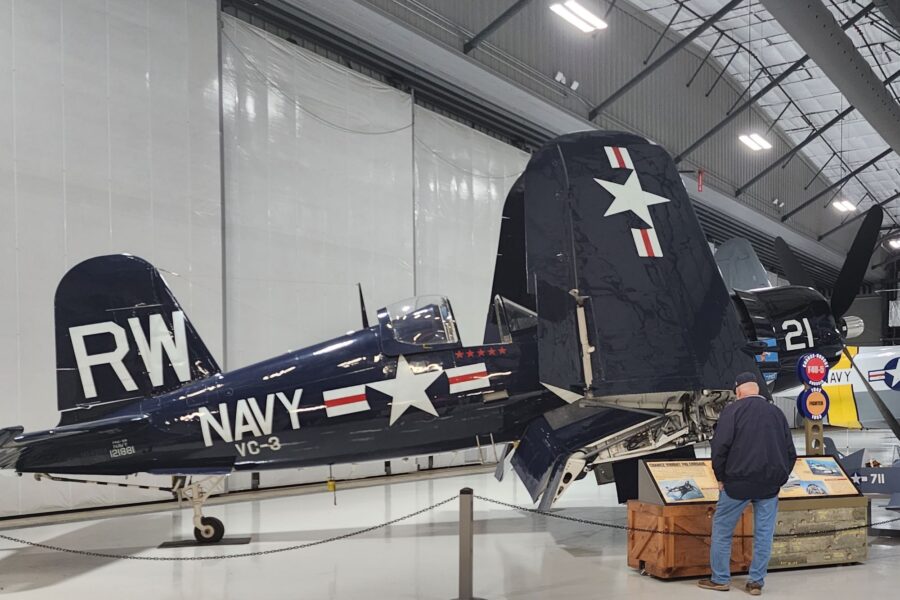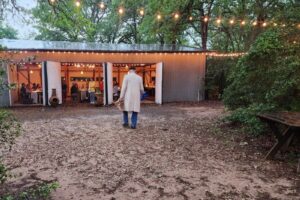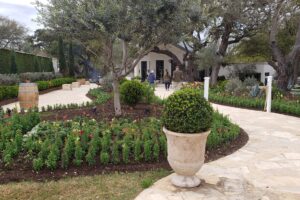When I looked at the map to see where we were going this morning, The Lone Star Flight Museum, I couldn’t help but notice that the other two museums we recently visited were a stone’s throw from each other. One is all about airline terminals, another about space exploration and spacecraft—and now this one—the appropriately in-between one is all about the history of flight and flying machines from warbirds and beyond—and before.
Pulling into the almost empty parking lot this chilly February morning, the first thing I think is—this place is big. I tell Michael, “The Lone Star Flight Museum looks bigger than the Johnson Space Center Visitor Center. Is that possible?” Silence.


The Lone Star Flight Museum



Now that I’m inside, I’m overwhelmed. My mind is boggled. I’m breathless. My head whirls and swims. This place isn’t what I was expecting. When Michael told me we would be touring the Lone Star Flight Museum, my imagination took me down the road to cold, dusty hangers crammed full of decrepit, rusted flying machines that I would know nothing about—with no words for me to read. No explanations—just creaky metal machines. I wasn’t excited. How wrong can a girl be? I need to sit down.
The First Hangar
The first hangar we walk into has gleaming planes of all shapes and sizes tucked into every nook and cranny on the cleanest, shiniest floor I have ever seen. All the flying machines on display look so new that it is hard to believe they didn’t just roll off the production line.


All the aircraft in this building were lovingly restored, and it all began because of one man, Robert Waltrip—a Houston native who became a wealthy businessman and loved planes as a boy. Waltrip was a pilot in WWII, and his fascination with flying machines never left him.
I stop at the first aircraft, a navy-blue warplane as black as night, a Corsair—a night fighter—and begin to read. The prototype was first built in 1938, and the Corsair’s maiden voyage took place in the late spring of 1940. The Corsair was used extensively in WWII in the Pacific Theater and flown well into the Korean War.






I move on to another plane and another storyboard, and another and another. Reading everything, I realize this may take forever. I look for Michael and can’t find him anywhere amid this forest of metal wings. After an overly long time, we bump into each other and look for a place to sit and rest. A museum volunteer comes up to us and tells us there is more.
Flight – Where it All Began
We wander into a room that is a learning center on aerodynamics, and I meet Danial Bernoulli, born in 1700, a Swiss mathematician and physicist, who had a principle, and his neighbor Isaac Newton—I know him—who was born more than a half-century before Bernoulli. Newton had three laws, and there are items that you can touch and feel and test to visualize all of them.



Michael walks up to me and says, “This room is for kids; I’m going across the hall.” And I let him go. I am far from a kid, but there are things to learn here. What I discover in the end is that I am way over my head. I guess you need to start very young with an innate curiosity about how things work—and why.
A Photographic Journey
I cross the hall and join Michael, looking at old photos and reading histories of people and events and places and planes. This, I understand.




Paintings of Douglas Ettridge
Before visiting the fourth exhibit hall—or second hangar—I stop in a long hallway and look at original art by Douglas Ettridge. It is nothing less than amazing. He was a London-based artist born in 1927 and apparently loved airplanes as much as Robert Waltrip.






If it weren’t for the backgrounds of where they fly and land, the paintings of these flying metal birds are so detailed and so exact that you would think you were looking at a photograph. I can’t even be jealous of his talent and his patience—his work is beyond my aspirations—I can only look in awe and appreciation.
A Butterfly, A Jet…
When we finally make our way to the second hangar display of gleaming aircraft, I understand why everything in this museum shines. In the distance, I see two men standing on ladders next to different airplanes, who polish, dust, and rub—probably wax—these amazingly restored machines. Keeping these planes sparkling seems like a never-ending job, akin to painting the Golden Gate Bridge—or housework.


Stopping and checking out what is right in front of me, I see a giant butterfly. How could you describe the plane before me as anything else? The Culver Dart, designed in the 1930s, is a two-seater light plane designed to be a fun-loving sports airplane. Its wings look like they will flutter once lifted by air—not remain rigid.


Across the aisle from the metal butterfly is the Visiting Plane of the Month, an Aero L-39 Albatros, a sleek jet built in Czechoslovakia. Designed in 1960, its maiden flight was at the end of 1968, and all I can think of is, you’ve come a long way, baby. Airplane design truly evolved in thirty years. Since 1990 nearly 3,000 L-39s have served over 30 air forces worldwide.
…and a Harley
I continue to walk and look and read until I bump into a most unlikely exhibit. A Harley Davidson Army Green Motorcycle stands before me! This motorcycle is not part of the permanent collection but is on loan from a patron. Apparently, after the US entered WWII, the Harley-Davidson Company built over 90,000 specially outfitted motorcycles for the US military and our allies.

Coffee Cups and Books
I continue my educational journey until I realize the clock wants to strike three. Michael and I head to the gift shop and buy two traveling mugs with a definite airplane theme. He adds a book—Unbroken A World War II Story of Survival, Resilience, and Resistance by Laura Hildebrand.
Our late lunch is a little beyond late today as we point our noses toward Gilhooley’s in San Leon. And, not for the first time in our lives, we leave a museum behind too soon. We are a little richer in knowledge and experience, with not enough time or energy to see it all and read it all.

For more information click on one of the following links:
Paintings of Douglas Ettridge – https://lonestarflight.org/aviationart/
Harley Davidson Motorcycles during WWII – https://usautoindustryworldwartwo.com/harleydavidson.htm
History of Aviation – https://study.com/learn/lesson/history-aviation-timeline-evolution-importance.html
Info on Visiting the Lone Star Flight Museum – https://lonestarflight.org/visit/visit/









Leave a Reply
Your email is safe with us.